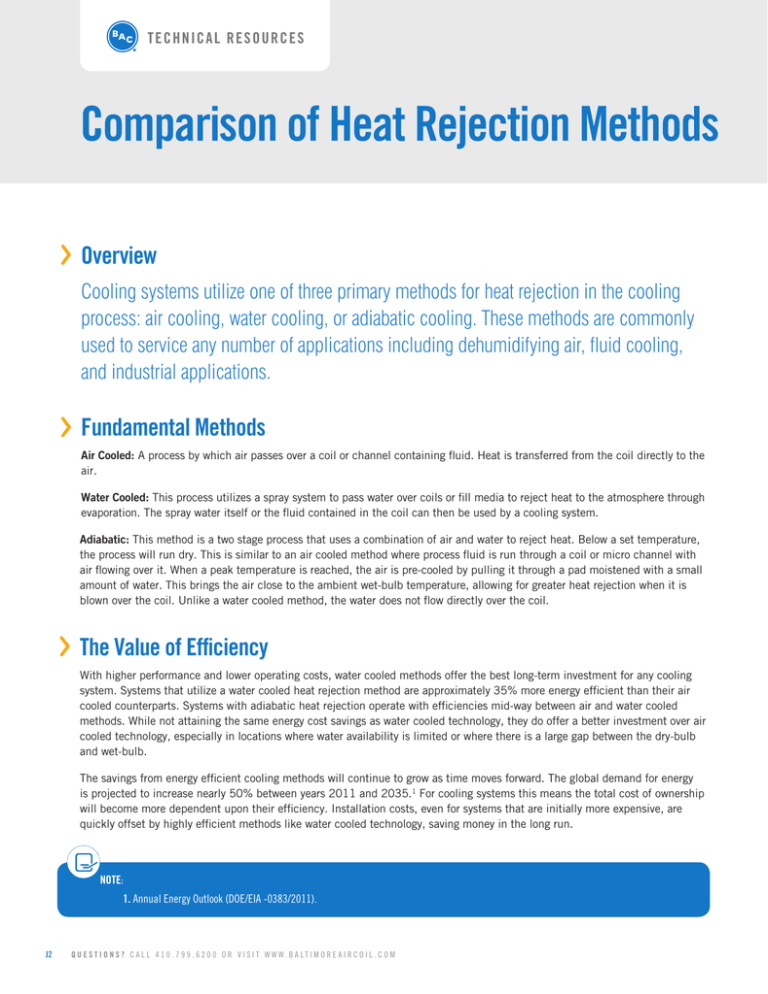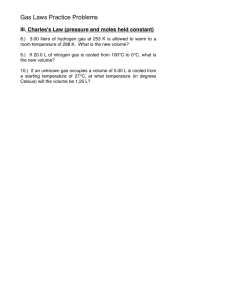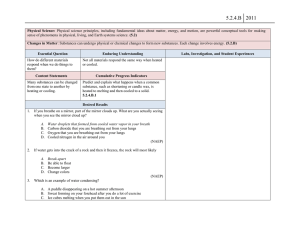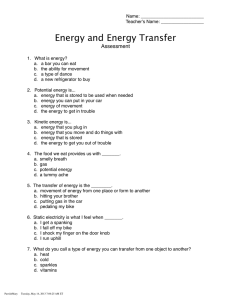Comparison of Heat Rejection Methods
advertisement

TECHNICAL RESOURCES Comparison of Heat Rejection Methods ››Overview Cooling systems utilize one of three primary methods for heat rejection in the cooling process: air cooling, water cooling, or adiabatic cooling. These methods are commonly used to service any number of applications including dehumidifying air, fluid cooling, and industrial applications. ››Fundamental Methods Air Cooled: A process by which air passes over a coil or channel containing fluid. Heat is transferred from the coil directly to the air. Water Cooled: This process utilizes a spray system to pass water over coils or fill media to reject heat to the atmosphere through evaporation. The spray water itself or the fluid contained in the coil can then be used by a cooling system. Adiabatic: This method is a two stage process that uses a combination of air and water to reject heat. Below a set temperature, the process will run dry. This is similar to an air cooled method where process fluid is run through a coil or micro channel with air flowing over it. When a peak temperature is reached, the air is pre-cooled by pulling it through a pad moistened with a small amount of water. This brings the air close to the ambient wet-bulb temperature, allowing for greater heat rejection when it is blown over the coil. Unlike a water cooled method, the water does not flow directly over the coil. ››The Value of Efficiency With higher performance and lower operating costs, water cooled methods offer the best long-term investment for any cooling system. Systems that utilize a water cooled heat rejection method are approximately 35% more energy efficient than their air cooled counterparts. Systems with adiabatic heat rejection operate with efficiencies mid-way between air and water cooled methods. While not attaining the same energy cost savings as water cooled technology, they do offer a better investment over air cooled technology, especially in locations where water availability is limited or where there is a large gap between the dry-bulb and wet-bulb. The savings from energy efficient cooling methods will continue to grow as time moves forward. The global demand for energy is projected to increase nearly 50% between years 2011 and 2035.1 For cooling systems this means the total cost of ownership will become more dependent upon their efficiency. Installation costs, even for systems that are initially more expensive, are quickly offset by highly efficient methods like water cooled technology, saving money in the long run. NOTE: 1. Annual Energy Outlook (DOE/EIA -0383/2011). J2 Q U E S T I O N S ? C A L L 4 1 0 . 7 9 9 . 6 2 0 0 O R V I S I T W W W. B A LT I M O R E A I R C O I L . C O M In addition to direct energy costs, cooling system selection can be affected by many local and national entities that are becoming increasingly focused on energy savings and environmental responsibility. Standards such as ASHRAE 90.1, regulations such as California Title 24, and certifications such as LEED® are different facets of this movement, all of which recognize the growing need for responsible energy consumption. Methods of heat rejection that meet these needs are more likely to be compliant with codes, approved for job sites, and even qualify for incentives. From project specification to daily operation, a cooling system’s efficiency will affect all aspects of a project. To get the best value for system owners, the method of heat rejection should be carefully analyzed for the life span of the cooling system. ››Installation Considerations There are many factors that can influence the selection of a cooling system. Typically the size of the system, the required design conditions, the operating sound level, along with the aforementioned efficiency, and price of the system all play a major role during the decision making process. Table 1 compares the three heat rejection methods against these criteria: Air Cooled Water Cooled Adiabatic Heat Transfer Medium Criteria Air Water Air and Water Temperature Effects Highly dependent on the ambient dry-bulb temperature, lower performance at higher temperatures Codependency on wet-bulb temperatures offers high performance across temperatures ranges Limited codependency on dry-bulb and wet-bulb temperatures provides a buffer for warm weather performance Efficiency Least Best Middle Footprint Largest Smallest Middle Water Usage None High Low Sound High Low Low Total Cost of Ownership High Low Middle No water usage Highest energy efficiency, most flexible temperature options Low maintenance and improved performance over air cooled methods Lowest efficiency, largest footprint per ton Highest water usage Limited capacity, lack of availability Benefits Challenges ››Comparison Summary Table 1. Comparison of Heat Rejection Methods Traditional systems using air cooled heat rejection will meet design specifications when absolutely no water is available; however, these systems require the most space, largest operating budget, and maintain the highest levels of sound during operation. Adiabatic based cooling systems are a technological improvement to air cooled methods, providing a middle ground on efficiency, sound, total cost of ownership, and ability to operate with minimal water. Systems with water cooled heat rejection offer the best performance, smallest foot print, largest capacity, and most ideal operating considerations. For a customized recommendation for the best heat rejection solution to meet your cooling needs contact your local BAC Representative. PRODUCT & APPLICATION HANDBOOK VOLUME V J3 TECHNICAL RESOURCES Comparison of Heat Rejection Methods ››Cost Analysis: Air Cooled vs. Water Cooled In the cooling industry there are two major technologies that dominate the marketplace: air cooled heat rejection and water cooled heat rejection. Other cooling methods exist, such as adiabatic technology, however their installations are limited and vary widely in performance based on the method of pre-cooling the air. As a result, the following analysis will only consider airbased and water-based chilled water cooling systems. The analysis will cover the costs for energy, water, water treatment, and equipment of each system. By comparing these values, the overall costs of ownership and advantages of each system can be determined. Design Assumptions In order to perform a detailed analysis, there are a number of assumptions that must be established. For a direct comparison, this example will consider two systems operating in identical environments, serving identical applications. The annual operating time for both systems is estimated at 4380 hours. Since the systems will not be operating at 100% load the entire time, this time is evaluated as the Integrated Part Load Value (IPLV), which accounts for a combination of loading conditions. The first system is equipped with a 500 ton water cooled, centrifugal chiller with a variable speed drive. The second system is a 500 ton air cooled rotary-screw water chiller. For each system, the following parameters will be used to determine their energy consumption: Parameter Water Cooled System Air Cooled System 0.6 1.255 Chiller Efficiency [IPLV] (kW/ton) 0.4 0.941 System Capacity (Tons) 500 500 Chiller Efficiency [Full Load] (kW/ton)1 1 IPLV Average Capacity (Tons) 290 290 Condenser Water Pump (HP) 30 — Cooling Tower Fan (HP) 30 — 4,380 4,380 Hours of Operation (Integrated Part Load Value) Energy Consumption Energy usage and the corresponding costs have the largest overall impact on the cost of a cooling system. To calculate the energy consumption the following energy equations can be applied to the design data for each system: Chiller Energy Usage = IPLV Efficiency * Average Capacity Peak Chiller Power = Full Load Efficiency * System Capacity Fan Energy Usage (kW) = Power (HP) * 0.7457 * IPLV Efficiency Peak Fan Power = Power (HP) * 0.7457 Condenser Pump Energy Usage (kW) = Power (HP) * 0.7457 Peak Energy Demand = Annual Energy Consumption = Hours of Operation * ∑ Energy Usage (Peak Chiller Power + Peak Fan Power + Condenser Pump Energy Usage) NOTES: 1. Minimum efficiency as required by ASHRAE 90.1-2010. J4 Q U E S T I O N S ? C A L L 4 1 0 . 7 9 9 . 6 2 0 0 O R V I S I T W W W. B A LT I M O R E A I R C O I L . C O M Applying these equations gives the following energy values for each system: Parameter Water Cooled System Air Cooled System Chiller Energy Usage (kW) 116 273 Condenser Pump Energy Usage (kW) 22 — Fan Energy Usage (kW) 9 — 645,259 1,195,258 345 628 Annual Energy Consumption (kWh at 4,380 IPLV) Peak Energy Demand (kW) Electricity Costs Electricity costs for each system depend upon the energy usage charge and demand charge. To calculate the costs, average utility rates as noted below are applied to the previously calculated energy values. The rates are in the mid-range for most of the national averages, however for individual projects the exact values will vary. In this case, the energy rate is calculated at $0.103/ kWh, and the demand rate at $13.44/kW. These rates can be applied using the equations below: Energy Usage Charge = Annual Energy Consumption * Energy Rate Demand Charge = Demand Rate * Peak Energy Demand (kW) This results in the following values: Energy Charge Water Cooled System Air Cooled System $66,462 $123,112 Demand Charge $4,633 $8,433 Total Annual Electricity Cost $71,095 $131,545 By looking at the total electricity cost for each system, it can be observed that the water cooled system electrical operating cost is approximately 46% lower than its air cooled counterpart. This gives the water cooled system a significant advantage over the air cooled system with regards to the continuing electricity costs for each system. There are, however, other factors beyond energy consumption that influence a system’s total operating cost. Water Costs Unlike an air cooled system, water cooled systems will incur annual water, sewage, and chemical treatment costs. These costs are best measured empirically, however they can be estimated from design parameters and operating conditions. For this example the costs for water, sewage, and chemical treatment are estimated for Baltimore, Maryland. As with the energy rates, the water costs for this area fall in the middle range of most national averages, however they will vary for specific installations. PRODUCT & APPLICATION HANDBOOK VOLUME V J5 TECHNICAL RESOURCES Comparison of Heat Rejection Methods For a system utilizing a cooling tower operating at a flow rate of 1500 USGPM, given a water supply charge of $2.90/1000 gal and sewage charge of $5.31/1000 gal, the associated water costs can be estimated as follows: Water Parameter Annual Cost Annual Water Supply $9,186 Annual Sewage $4,047 Annual Chemical Treatment $7,000 Annual Water Related Costs $20,233 Total Annual Costs The sum of water and energy related costs make up the bulk of the total operating cost for a cooling system. Due to their frequency and amount, these expenditures comprise the majority of the total cost of ownership throughout the lifetime of the system. Given a sufficient period of time, the system with a lower annual cost will provide greater savings during the lifecycle of the cooling system. In this case, it can be observed that the water cooled system offers approximately 31% savings on annual costs. This savings maintains the water cooled advantage identified in the total electricity costs. The exact annual totals for each system are as follows: Total Annual Cost: Water Cooled System Air Cooled System $91,328 $131,545 Equipment and Installation Costs Unlike energy and water costs, equipment and installation costs represent a single expenditure that only occurs at the beginning of the cooling system’s life cycle. Systems utilizing air cooled technology often use fewer components and in this regard carry an installation advantage over water cooled systems. Estimated costs for equipment and installation of each system are listed below. These values have been collected from multiple sources and will vary for individual installations. 500 Ton Air Cooled Chiller System Costs Air Cooled Chiller, 500 Ton Equipment Cost Installation Cost2 $171,500 $16,700 500 Ton Air Cooled Chiller System Costs 500 Ton Water Cooled Chiller System Costs Equipment Cost Installation Cost2 Water Cooled Centrifugal Chiller, 500 Ton $125,000 $15,300 Axial Fan, Induced Draft, 500 Ton Cooling Tower $46,800 $5,150 250 L.F. Chilled Water Piping $6,875 $12,748 30 HP Condenser Pump $6,550 $1,210 Mechanical Room Space $22,400 Total: $207,625 500 Ton Water Cooled Chiller System Costs NOTE: 2. Installation cost does not include material cost associated with connecting the equipment to the system. J6 Q U E S T I O N S ? C A L L 4 1 0 . 7 9 9 . 6 2 0 0 O R V I S I T W W W. B A LT I M O R E A I R C O I L . C O M $34,408 ››Total Cost Comparison The total for any system will be a combination of an initial cost plus a recurring annual cost. Over the lifetime of a system the annual costs will constitute the majority of the total expenditures. Below are the total costs for both systems where the annual cost will occur every year of the cooling system’s usable life: Water Cooled System Air Cooled System Equipment and Installation Cost 500 Ton System $242,033 $188,200 Total Annual Cost $91,328 $131,545 Water Cooled Payback Period: 1.3 years An important figure to consider when comparing these two systems is the cost difference payback period. This period is the time it will take for the total cost of the system with the higher initial cost to become equal in cost to the other system. In this example, it can be observed that the water cooled system has approximately $54,000 more in initial equipment and installation costs; however, this system incurs approximately $40,000 less in annual costs. After approximately 1.3 years the $54,000 gap will be eliminated through annual savings. After this time, the total costs for a water cooled system will offer significant savings over the air cooled system. Given that the reasonable life span of a water based cooling system is approximately 17 years, the total water cooled benefit is approximately $630,000; resulting in a clear financial advantage over the air cooled system. ››Conclusion Air cooled systems may offer lower initial costs, but they cannot compete in regards to the total cost of ownership except in locations with a combination of very low electricity costs and very high water costs. The benefits of water cooled systems are directly linked to their efficiency of operation. By consuming less electricity, these types of systems save end users money and energy over the lifetime of their cooling system. Furthermore, as global energy demands continue to rise, the cost for electricity will increase accordingly. As these changes happen, the cost of operation will become even more important, giving further advantage to water cooled systems. The analysis presented here provides a valid basis for determining overall trends among the major contributors to cooling system costs. There are, however, additional aspects that can influence the cost of ownership. For example, air cooled systems generally operate at higher sound levels than water cooled systems. For comparable acoustical performance, an air cooled system would need to be equipped with low sound accessories. There are also operating environment considerations that should be taken into account. In coastal regions, air cooled equipment must be equipped with special coil coatings to ensure reliable operation. The additional cost of these accessories would increase the initial cost of the air cooled system and shorten the payback period of the water cooled system. Furthermore, since water cooled systems have a smaller footprint per ton, the overall space requirements and aesthetics of system components may very well factor into the choice of cooling products. For assistance with system selection and the specific benefits that a water cooled system can offer you, contact your local BAC Representative. PRODUCT & APPLICATION HANDBOOK VOLUME V J7


